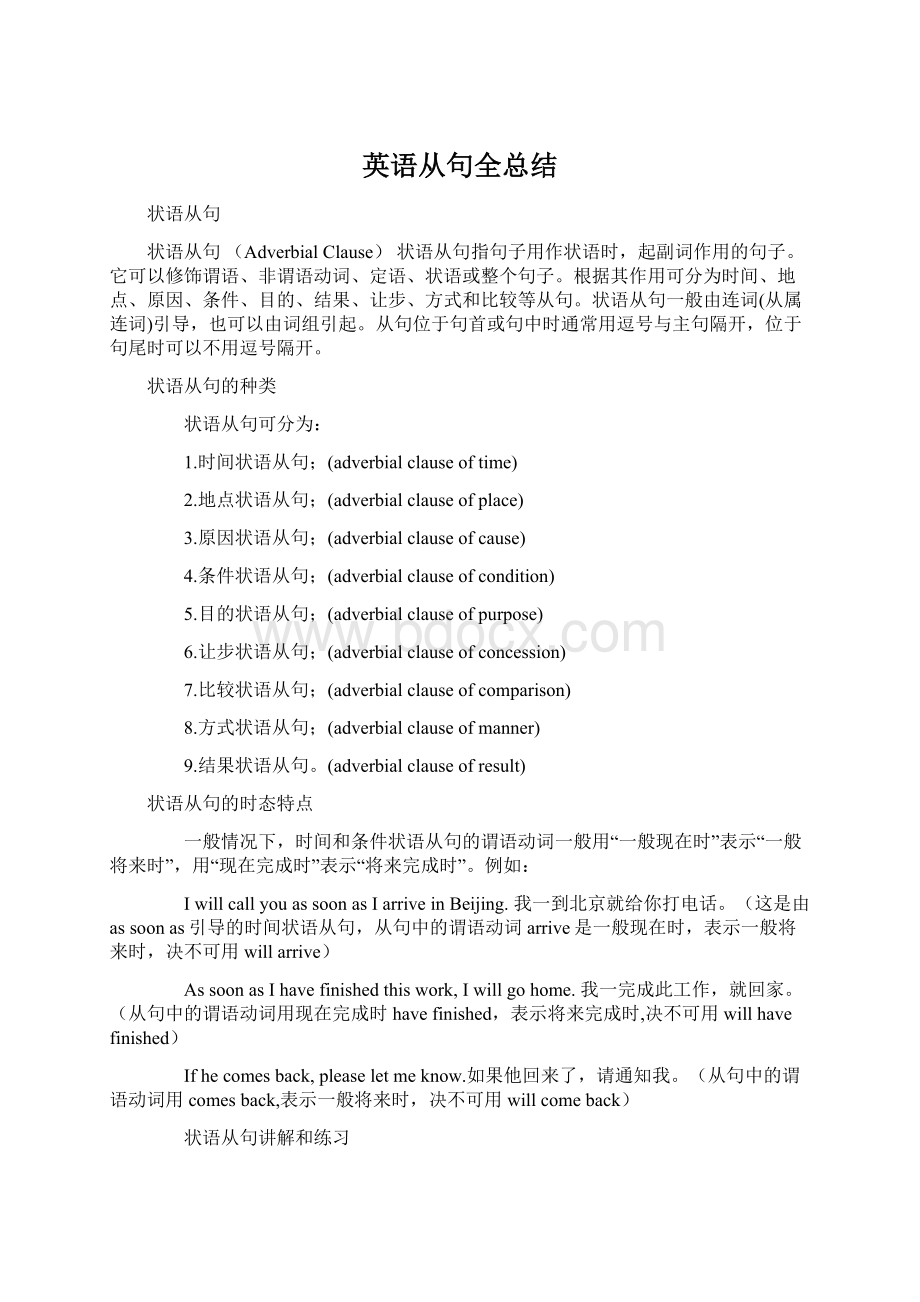英语从句全总结.docx
《英语从句全总结.docx》由会员分享,可在线阅读,更多相关《英语从句全总结.docx(47页珍藏版)》请在冰豆网上搜索。

英语从句全总结
状语从句
状语从句(AdverbialClause)状语从句指句子用作状语时,起副词作用的句子。
它可以修饰谓语、非谓语动词、定语、状语或整个句子。
根据其作用可分为时间、地点、原因、条件、目的、结果、让步、方式和比较等从句。
状语从句一般由连词(从属连词)引导,也可以由词组引起。
从句位于句首或句中时通常用逗号与主句隔开,位于句尾时可以不用逗号隔开。
状语从句的种类
状语从句可分为:
1.时间状语从句;(adverbialclauseoftime)
2.地点状语从句;(adverbialclauseofplace)
3.原因状语从句;(adverbialclauseofcause)
4.条件状语从句;(adverbialclauseofcondition)
5.目的状语从句;(adverbialclauseofpurpose)
6.让步状语从句;(adverbialclauseofconcession)
7.比较状语从句;(adverbialclauseofcomparison)
8.方式状语从句;(adverbialclauseofmanner)
9.结果状语从句。
(adverbialclauseofresult)
状语从句的时态特点
一般情况下,时间和条件状语从句的谓语动词一般用“一般现在时”表示“一般将来时”,用“现在完成时”表示“将来完成时”。
例如:
IwillcallyouassoonasIarriveinBeijing.我一到北京就给你打电话。
(这是由assoonas引导的时间状语从句,从句中的谓语动词arrive是一般现在时,表示一般将来时,决不可用willarrive)
AssoonasIhavefinishedthiswork,Iwillgohome.我一完成此工作,就回家。
(从句中的谓语动词用现在完成时havefinished,表示将来完成时,决不可用willhavefinished)
Ifhecomesback,pleaseletmeknow.如果他回来了,请通知我。
(从句中的谓语动词用comesback,表示一般将来时,决不可用willcomeback)
状语从句讲解和练习
状语修饰动词、形容词、副词或整个句子。
通常由副词、介词短语、动词不定式、分词和从句等担当。
例如:
1.Naturally,ourgrandparentswerepleasedtogetourphonecall.(副词)
2.Weworkedhard,fromsunrisetosunset.(介词状短语)
3.Tohelpmydisabledaunt,Ispendanhourworkinginherhouseeveryday.(不定式)
4.Seenfromadistance,thefarmhouselookeddeserted.(过去分词)
5.IknowhowtolightacampfirebecauseIhaddoneitbefore.(原因状语从句)
状语的位置比较灵活,可以位于句首、句末或句中。
enough用作状语修饰形容词和副词时必须后置。
状语从句主要用来修饰主句或主句的谓语。
一般可分为九大类,分别表示时间、地点、原因、目的、结果、条件、让步、比较和方式。
尽管种类较多,但由于状语从句与汉语结构和用法相似,所以理解和掌握它并不难。
状语从句的关键是要掌握引导不同状语从句的常用连接词
和特殊的连接词即考点。
现分别列举如下:
1.时间状语从句
常用引导词:
when,as,while,assoonas,before,after,since,till,until
特殊引导词:
theminute,themoment,thesecond,everytime,theday,theinstant,immediately,directly,nosooner…than,hardly…when,scarcely…when
Ididn’trealizehowspecialmymotherwasuntilIbecameanadult.
WhileJohnwaswatchingTV,hiswifewascooking.
Thechildrenranawayfromtheorchard(果园),themomenttheysawtheguard.
NosoonerhadIarrivedhome,thenitbegantorain.
EverytimeIlistentoyouradvice,Igetintotrouble.
2.地点状语从句
常用引导词:
where
特殊引导词:
wherever,anywhere,everywhere
Generally,airwillbeheavilypollutedwheretherearefactories.
Whereveryougo,youshouldworkhard.
3.原因状语从句
常用引导词:
because,since,as,for
特殊引导词:
seeingthat,nowthat,inthat,consideringthat,giventhat.
MyfriendsdislikemebecauseI’mhandsomeandsuccessful.
Nowthateverybodyhascome,let’sbeginourconference.
Thehigherincometaxisharmfulinthatitmaydiscouragepeoplefromtryingtoearnmore.
Consideringthatheisnomorethan12yearsold,hisheightof1.80misquiteremarkable.
4.目的状语从句
常用引导词:
sothat,inorderthat
特殊引导词:
lest,incase,forfearthat,inthehopethat,forthepurposethat,totheendthat
Thebossaskedthesecretarytohurryupwiththeletterssothathecouldsignthem.
Theteacherraisedhisvoiceonpurposethatthestudentsinthebackcouldhearmoreclearly.
5.结果状语从句
常用引导词:
so…that,such…that,
特殊引导词:
suchthat,tothedegreethat,totheextentthat,tosuchadegreethat,
Hegotupsoearlythathecaughtthefirstbus.
It’ssuchagoodchancethatwemustnotmissit.
Tosuchandegreewasheexcitedthathecouldn’tsleeplastnight.
6.条件状语从句
常用引导词:
if,unless,
特殊引导词:
as/solongas,onlyif,providing/providedthat,supposingthat,incasethat,onconditionthat
We’llstartourprojectifthepresidentagrees.
Youwillcertainlysucceedsolongasyoukeepontrying.
Providedthatthereisnoopposition,weshallholdthemeetinghere.
7.让步状语从句
常用引导词:
though,although,evenif,eventhough
特殊引导词:
as(用在让步状语从句中必须要倒装),while(一般用在句首),nomatter…,inspiteofthefactthat,while,whatever,whoever,wherever,whenever,however,whichever
MuchasIrespecthim,Ican’tagreetohisproposal.
尽管我很尊敬他,我却不同意他的建议。
Theoldmanalwaysenjoysswimmingeventhoughtheweatherisrough.
Nomatterhowhardhetried,shecouldnotchangehermind.
Hewon’tlistenwhateveryoumaysay.
8.比较状语从句
常用引导词:
as(同级比较),than(不同程度的比较)
特殊引导词:
themore…themore…;justas…,so…;AistoBwhat/asXistoY;no…morethan;notAsomuchasB
Sheisasbad-temperedashermother.
Thehouseisthreetimesasbigasours.
Themoreyouexercise,thehealthieryouwillbe.
Foodistomenwhatoilistomachine.食物之于人,犹如油之于机器。
9.方式状语从句
常用引导词:
as,asif,how
特殊引导词:
theway
WheninRome,doastheRomando.
Shebehavedasifsheweretheboss.
Sometimesweteachourchildrenthewayourparentshavetaughtus.
10.状语从句的简化
♠状语从句的省略
状语从句同时具备下列两个条件:
①主句和从句的主语一致,或从句主语为it;②从句主要动词是be的某种形式。
从句中的主语和be动词常可省略。
例如:
When(themuseumis)completed,themuseumwillbeopentothepublicnextyear.
He’llgototheseasideforhisholidayif(itis)possible.
另外,比较状语从句经常省略。
例如:
I’mtallerthanhe(istall).
Thehigherthetemperature(is),thegreaterthepressure(is).
就状语从句而言,有时为了使语言言简意赅,常常将状语从句进行"简化"。
状语从句的"简化"现象在口语中较为普遍,而且在高考中的复现率也较高。
因此,有必要对其进行全面、透彻的了解。
状语从句的"简化"现象常存在于以下五种状语从句中:
①由if,unless等引导的条件状语从句;②由although,though,evenif/though等引导的让步状语从句;③由when,while,as,before,after,until/till等引导的时间状语从句;④由as,asif等引导的方式状语从句;⑤由as,than等引导的比较状语从句。
下面针对这五种情形作一归纳。
(1)当状语从句的主语是it,且谓语动词是be时,it和be要完全简化掉。
例如:
If(itis)possible,hewillhelpyououtofthedifficulty.如果可能的话,他会帮你摆脱困境。
Youmustattendthemeetingunless(itis)inconvenienttoyou.除非情况对你来说不方便,否则你必须出席这次会议。
(2)当状语从句的主语和主句的主语一致时,从句可以将主语和be动词简化掉。
常用于以下几种情形:
a.连词+形容词
As(hewas)young,helearnedhowtorideabike.他小时候就学会了骑自行车。
Whenever(sheis)free,sheoftengoesshopping.她有空就去逛商店。
Workhardwhen(youare)young,oryou'llregret.少壮不努力,老大徒伤悲。
b.连词+名词
While(hewas)ayoungboy,hewasalwaysreadytohelpothers.他在孩提时代就乐于助人。
Although(hewas)afarmer,nowheisafamousdirector.尽管他曾是个农民,而现在是位著名的导演了。
c.连词+现在分词
As(shewas)walkingalongtheriverbank,shewassingingapopsong.她沿着河堤边走边唱着流行歌曲。
Although(heis)doinghisbestinmathsthesedays,hehasstillgotnogoodmarks.尽管近来他一直在学数学,但他仍然没有取得好成绩。
d.连词+过去分词
Hewon'tgotherewithusunless(heis)invited.除非受到邀请,否则他不会和我们一道去那里。
Theconcertwasagreatsuccessthan(itwas)expected.这场音乐会出乎意料地取得了巨大成功。
e.连词+不定式
Hestoodupasif(hewere)tosaysomething.当时他站起来好像要说什么。
Hewouldn'tsolvetheproblemevenif(hewere)totakecharge.即使他来负责,他也解决不了这个问题。
f.连词+介词短语
Shelookedanxiousasthough(shewas)introuble.她看上去很焦急,好像遇到了麻烦。
HehadmasteredtheEnglishlanguagebefore(hewas)intheUSA.他到美国之前就懂英语了。
注意:
当从句主语和主句主语不一致时,从句部分要么用完全形式,要么用独立主格结构来表达。
例如:
Whenthemeetingwasover,allthepeoplewentoutofthemeeting-room.当会议结束时,人们都走出了会议室。
(=Themeetingover,
一、时间状语从句
概念:
在复合句中,由时间连接词引导的状语从句叫做时间状语从句。
(在复合句中,要注意主句和从句的时态大多都要保持一致。
)
要点:
时间状语从句,由以下连词引导:
whenwhileasafterbeforeassoonassincetill/untilbythetime在时间状语从句中,要注意时态一致。
一般情况下主句是将来时的时候,从句要用一般现在时。
1.when当...的时候
Mozartstartedwritingmusicwhenhewasfouryearsold.
(当)莫扎特4岁的时候,开始写音乐作品。
2.while当...时
Hevisitedalotofplaceswhilehewastraveling.
他在旅途中参观了许多地方。
3.as在...的同时;一边...一边...
Hesmiledashestoodup.
他一边站起来一边笑着。
4.after在...之后
Helefttheclassroomafterhehadfinishedhishomeworktheotherday.
前几天做完作业之后回的家。
5.before在...之前
Mr.Brownhadworkedinabankforayearbeforehecamehere.
布朗先生来这之前已经在一家银行里工作一年了。
6.assoonas一...就...
Webegantoworkassoonaswegotthere.
我们一到那就开始工作。
IwillwritetoyouassoonasIgethome.
我一到家就给你写信。
7.since自。
。
。
以来到现在
表示自过去的一个起点时间到目前(说话时间)为止的一段持续时间。
主句一般用现在完成时,从句用一般过去时。
MrGreenhastaughtinthatschoolsincehecametoChinathreeyearsago.
自格林先生来中国以来,他就在这所学校教书。
(还可以用作介词,本句从句还可以用短语:
sincethreeyearsago(自三年前以来)表示。
)
8till/until
都可以作连词,连接时间状语,也可以作介词,与其它词构成介词短语,在句中作状语。
Theywalkedtill/untilitwasdark.
他们一直走到天黑。
XiaoMingdidn’tleavehometill/untilhisfathercameback.
小明直到他爸爸回来才离开家。
9.bythetime到。
。
。
为止(所在句子的主句应用完成时)
Bythetimehegetsthere,hisfatherhasalreadygone.
他到家的时候,他爸爸已经走了。
BythetimeIgottoschool,theclasshadalreadybegan.
我到校时,已经开始上课了。
时间状语从句(adverbialclauseoftime)
1.由when,while,as引导的时间状语从句。
例如:
Whenyouthinkyouknownothing,thenyoubegintoknowsomething.当你以为自己一无所知的时候,你就是在开始知道一些事物了。
Whentruthisburiedunderthegrounditgrows,itchokes,itgatherssuchanexplosiveforcethatonthedayitburstsout,itblowsupeverythingwithit.当真理被埋在地下的时候,它在生长,它感到压抑,它蓄存着这么一种爆炸性力量,一旦冒出,它就会炸破一切!
Strikewhiletheironishot.趁热打铁。
WillyouwatchmyclotheswhileIhaveaswim.我游泳的时候,请你照看一下我的衣服。
Youcanfeeltheairmovingasyourhandpushesthroughit.当你的手在空气中挥动的时候,你就能感觉到空气在流动。
Ourheadmasterlaughedasshespoke.我们的校长边谈边笑。
when,while和as的区别
when引导的从句的谓语动词可以是延续性的动词,又可以是瞬时动词。
并且when有时表示“就在那时”。
例如:
Whenshecamein,Istoppedeating.她进来时,我停止吃饭。
(瞬时动词)
WhenIlivedinthecountryside,Iusedtocarrysomewaterforhim.当我住在农村时,我常常为他担水。
(延续性的动词)
Wewereabouttoleavewhenhecamein.我们就要离开,就在那时他进来了。
While引导的从句的谓语动词必须是延续性的,并强调主句和从句的动作同时发生(或者相对应)。
并且while有时还可以表示对比。
例如:
Whilemywifewasreadingthenewspaper,IwaswatchingTV.(wasreading是延续性的动词,wasreading和waswatching同时发生)
Ilikeplayingfootballwhileyoulikeplayingbasketball.我喜欢踢足球,而你喜欢打篮球。
(对比)
As表示“一边……一边”,as引导的动作是延续性的动作,一般用于主句和从句动作同时发生;as也可以强调“一先一后。
例如:
Wealwayssingaswewalk.我们总是边走边唱。
(as表示“一边……一边”)
Aswewasgoingout,itbegantosnow.当我们出门时,开始下雪了。
(as强调句中两个动作紧接着先后发生,而不强调开始下雪的特定时间)
aswhenwhile的辨析
aswhenwhile都表示主、从句动作同时发生,三者差异如下:
表示“一边。
。
。
一边"的意思
as强调两个动作同时进行,并表示对比时
用于发生时间较短时
when
1、还可以表示从